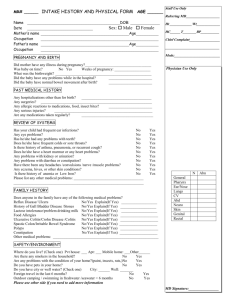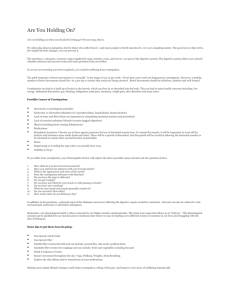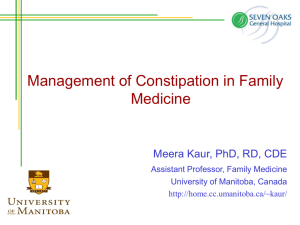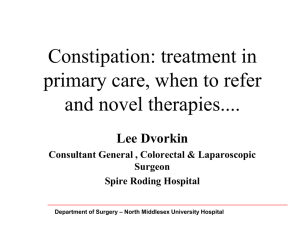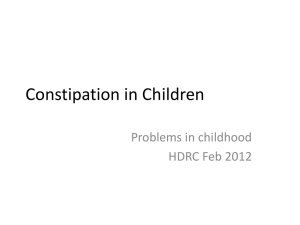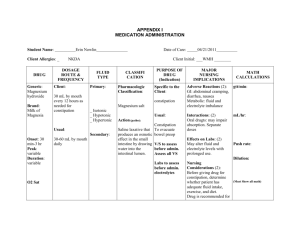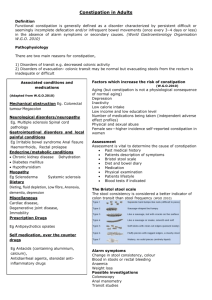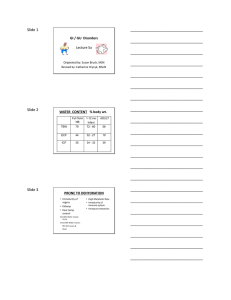Quality Is No Accident - University of Massachusetts Medical School
advertisement
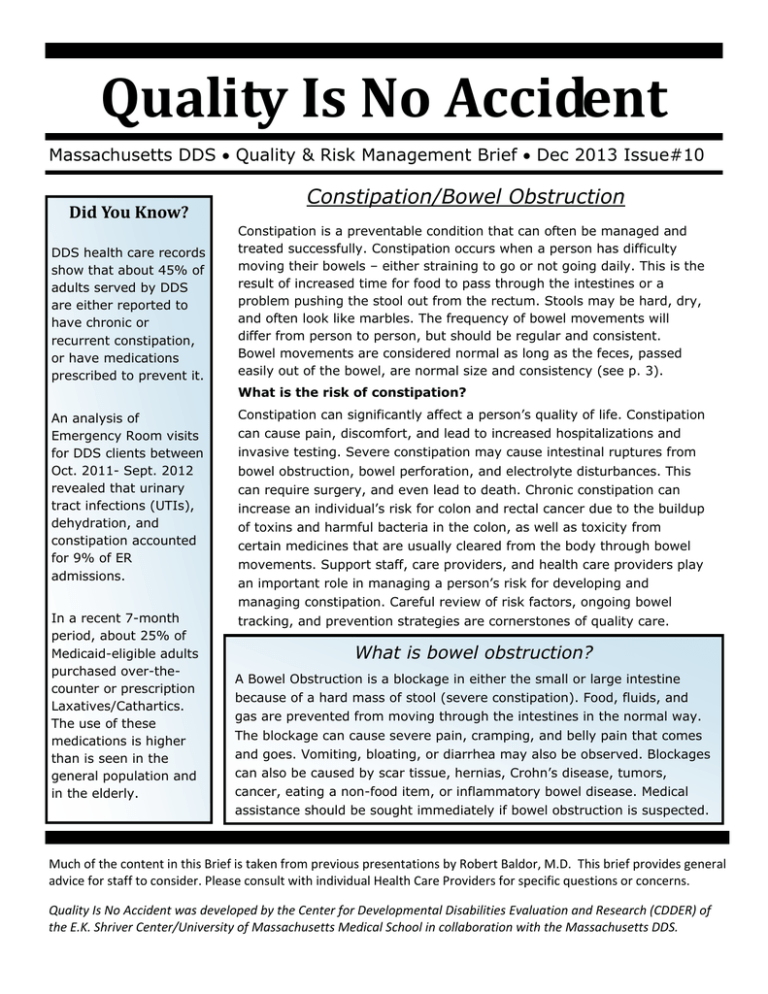
QualityIsNoAccident Massachusetts DDS Quality & Risk Management Brief Dec 2013 Issue#10 DidYouKnow? DDS health care records show that about 45% of adults served by DDS are either reported to have chronic or recurrent constipation, or have medications prescribed to prevent it. Constipation/Bowel Obstruction Constipation is a preventable condition that can often be managed and treated successfully. Constipation occurs when a person has difficulty moving their bowels – either straining to go or not going daily. This is the result of increased time for food to pass through the intestines or a problem pushing the stool out from the rectum. Stools may be hard, dry, and often look like marbles. The frequency of bowel movements will differ from person to person, but should be regular and consistent. Bowel movements are considered normal as long as the feces, passed easily out of the bowel, are normal size and consistency (see p. 3). What is the risk of constipation? An analysis of Emergency Room visits for DDS clients between Oct. 2011- Sept. 2012 revealed that urinary tract infections (UTIs), dehydration, and constipation accounted for 9% of ER admissions. In a recent 7-month period, about 25% of Medicaid-eligible adults purchased over-thecounter or prescription Laxatives/Cathartics. The use of these medications is higher than is seen in the general population and in the elderly. Constipation can significantly affect a person’s quality of life. Constipation can cause pain, discomfort, and lead to increased hospitalizations and invasive testing. Severe constipation may cause intestinal ruptures from bowel obstruction, bowel perforation, and electrolyte disturbances. This can require surgery, and even lead to death. Chronic constipation can increase an individual’s risk for colon and rectal cancer due to the buildup of toxins and harmful bacteria in the colon, as well as toxicity from certain medicines that are usually cleared from the body through bowel movements. Support staff, care providers, and health care providers play an important role in managing a person’s risk for developing and managing constipation. Careful review of risk factors, ongoing bowel tracking, and prevention strategies are cornerstones of quality care. What is bowel obstruction? A Bowel Obstruction is a blockage in either the small or large intestine because of a hard mass of stool (severe constipation). Food, fluids, and gas are prevented from moving through the intestines in the normal way. The blockage can cause severe pain, cramping, and belly pain that comes and goes. Vomiting, bloating, or diarrhea may also be observed. Blockages can also be caused by scar tissue, hernias, Crohn’s disease, tumors, cancer, eating a non-food item, or inflammatory bowel disease. Medical assistance should be sought immediately if bowel obstruction is suspected. Much of the content in this Brief is taken from previous presentations by Robert Baldor, M.D. This brief provides general advice for staff to consider. Please consult with individual Health Care Providers for specific questions or concerns. Quality Is No Accident was developed by the Center for Developmental Disabilities Evaluation and Research (CDDER) of the E.K. Shriver Center/University of Massachusetts Medical School in collaboration with the Massachusetts DDS. Risk Assessment Understanding common risk factors for constipation may help with designing effective prevention and treatment options. When evaluating a person’s risk for constipation, consider the following: Medication Side Effects Many medications have constipating side effects because they slow down gastric motility or draw too much fluid from the gastrointestinal tract. These include: Calcium and iron supplements Antidepressants Antipsychotics like clozapine, thioridazine, olanzapine, and chlorpromazine Diuretics (lasix) Antacids Medications: About 50% of adults supported by DDS regularly take medications that can result in constipation (Analysis of DDS Health Care Records, July 2012). General Risk Factors for Constipation: Lack of fluids in the diet People unable to communicate thirst Lack of fiber in the diet Lack of regular exercise Muscle weakness Poor swallowing skills with aspiration risk People who depend on others for reminders or assistance with toileting People with spina bifida or other neuromuscular disorders Wheelchair use or limited mobility Ingestion of non-food items or Pica Prior history of constipation Repression of the urge to move bowels due to psychiatric issues Constipation Signs: Be alert to subtle signs and symptoms of constipation, which can look different in each person. This might include a bloated or tender stomach, grunting or straining during bowel movements, blood with bowel movements, infrequent or irregular bowel movements (less than 3 per week with lumpy or hard stool that is difficult to pass), or changes in bowl movement size or consistency. Could this be Constipation? Decreased appetite or a refusal to eat, irritable, aggressive behaviors, or new/ ongoing urinary tract infections (especially in women) may be symptoms of constipation that are often unrecognized. Helpful Hint: Hemorrhoids are most often caused by constipation, due to straining to move the bowels. If someone has hemorrhoids, treatment for underlying constipation may also be considered. Prevention & Treatment Options Daily monitoring for constipation is an important and recommended practice. This will provide a consistent record of bowel habits, particularly if any risk factors are present, and help determine if the individual is constipated. This may also help facilitate communication with other staff or health care providers. Bristol Stool Chart: This chart is an ideal guide for characterizing bowel movements. Generally, Types 1–2 indicate constipation. Type 3 and 4 are ideal because they are easy to pass and don’t contain excess liquid. Types 5, 6 and 7 tend towards diarrhea Daily Bowel Charts can be kept on a calendar or chart. Many examples are available for free on the internet. Daily charting should include the size (small, medium, large), texture (hard, soft, loose), color, and document associated blood or discomfort. Lewis SJ, Heaton KW (1997). Stool form scale as a useful guide to intestinal transit time. Scand. J. Gastroenterol. 32 (9): 920–4. http://www.gpnotebook.co.uk/simplepage.cfm?ID=x20100606160522260465 Diet & Exercise The MOST IMPORTANT prevention strategy is to increase fluids. o Helpful Hint: Fluids include water as well as other liquids such as juice, milk, tea, or even Jell-0. o Offer drinks frequently to those you support. Regularly scheduled fluid breaks may help. o Other strategies for increasing fluids: Experiment with different temperatures of liquid. Some people prefer liquids at room temperature, especially if they’ve had dental work. Drinking water or tea can be a social event by having afternoon tea breaks, for example. Flavored water may also help. Increase fiber (20g/day) through consumption of whole grains, beans, fresh fruits, and vegetables. o Metamucil may be prescribed. Metamucil may cause constipation if not consumed with enough water. o About 8oz of water is needed for 1 tablespoon of Metamucil. Increase regular exercise Medications Health care providers may prescribe a variety of laxatives or other medications, including: Stool softeners like Colace to help with pushing out the stool. Miralax (generic name: PEG 3350) to help soften the stool. o Helpful Hint: Try dissolving Miralax in water or applesauce. Miralax is tasteless and non-gritty. Stimulants, such as Senna, to help stimulate the large intestines to contract and move the stool along. Lubricants to help clean out the bowels. Lubricants may not be appropriate for people with aspiration risk. Duclolax suppository and/or Fleets enema. Follow regular bowel regimens and establish a toileting routine Mornings are the best time to move the bowels, about 10 minutes after eating or drinking. Plenty of time should be given on the toilet. A positioning schedule for non-mobile individuals with time in an upright position (Physical Therapist consultation may be needed). Staff Training: Staff should recognize normal/abnormal bowels and become familiar with individual patterns. Staff should follow individual bowel protocols including when and how to give medications, specialized instructions, documentation needs, and when to report or call physician or program nurse. What we know from the data Emergency Room Visits 1 Constipation was among the top diagnoses related to Emergency Room visits between Oct 2011 – Sept 2012 of adults receiving DDS services and whose incident information is recorded in HCSIS. In the Oct 2011- Sept 2012 data, 488 or 6.5% of ER visits did not have enough information to discern the reason for the visit. 1 Behavioral Issues Rank 1. 2. 3. 4. 5. 6. 7. 8. 9. 10. 11. 12. 13. 14. 15. Diagnosis Physical injuries (non-burn) Seizures Respiratory infections Urinary Tract Infection G/j-tube related Skin Infections Cardiovascular Symptoms Infection (systemic) Psychiatric Gastroenteritis & Other Gastro Dehydration Constipation Choking/Aspiration Diabetes-related Anxiety Oct 2011- Sept 2012 # % of Incidents diagnoses 2129 31.0% 482 7.0% 452 6.6% 365 5.3% 243 3.5% 186 2.7% 179 2.6% 172 2.5% 144 2.1% 141 2.1% 127 1.8% 122 1.8% 86 1.3% 74 1.1% 56 0.8% Constipation may be an underlying cause for behavioral issues. In a study of adults with intellectual disabilities (ID) admitted to the hospital for psychiatric care due to significant behavioral issues (Charlot et al; 2011), over 60% were found to also have constipation. In many of these cases, treating the constipation resulted in positive changes in behavior. Behavioral changes, especially new or ongoing irritable or aggressive behaviors, should be included in a constipation evaluation. *Gastroesophageal reflux disease (GERD) Charlot, L., et al (2011), Non-psychiatric health problems among psychiatric inpatients with intellectual disabilities. JIDR, 55: 199–209.) Constipation Resources: MA DDS fact sheets for observing signs & symptoms http://www.mass.gov/eohhs/consumer/disability-services/services-by-type/intellectual-disability/providersupport/health-promotion/developmental-services-hpci-signs-of-illness.html MA DDS Risk Management Guidelines http://www.mass.gov/eohhs/consumer/disability-services/services-by-type/intellectual-disability/providersupport/health-promotion/risk-management.html DDS/CDDER Webinar on Constipation and Bowel Obstructions with Dr. Bob Baldor. Presentation slides and audio archived here: http://www.umassmed.edu/cdder/webinar-constipation.aspx Analyses conducted by: Center for Developmental Disabilities Evaluation and Research (CDDER), E.K. Shriver Center, UMass Medical School For more information, please contact: Sharon Oxx, RN, CDDN, Director of Health Services, DDS Sharon.Oxx@state.ma.us
